Virtual Maritime Academy
-
- Leading a Sea of Change Maritime Reporter, Mar 2001 #46
The Marine industry, and especially the world shipping industry, has seen many changes in the past three decades. These changes have come about partly as a result of the economic crises in the world and partly because of the very rapid advancement of technological innovations.
The world recession forced many ports, shipyards, shipping companies and related industries to close down. This, together with increase in the oil prices, demanded a new generation of ships, which are cheaper to run, more efficient and carry more cargo but fewer personnel. The new era in computer and automation technology has helped the design of these ships in many respects. Using digital computers it has become possible to solve problems, which have been very difficult or impossible to solve until very recently. This has resulted in an improvement in the theoretical basis of ship design. Computer-aided design and optimization techniques are now part of the design task, which make the final design a more refined piece of work than what used to be the case. It is now possible to store large amounts of data from previous designs in data banks and refer to them when necessary.
All these, together with the advancement of science in other related fields, have resulted in ships being designed and built with revolutionary hull forms and machinery, which have totally different maneuvering characteristics when compared with more conventional ships. These new ships range from fast passenger and container ships, some of which have large areas exposed to the wind when loaded with deck cargo, to ultra-large crude carriers with substantial physical dimensions requiring very deep water and large turning basins for their safe navigation. These ships and have to go in and out of ports in almost all weather conditions in a matter of hours.
Port operators, in order to remain competitive and also to attract more customers, have to make certain that their ports are equipped with all the facilities required for handling these ships and also to ensure their safe passage within the port area. This latter problem is then referred to the port design consultants serving the port authorities to ensure that ships of different types and sizes can navigate safely within the harbor areas and suggest any maintenance program and/or modifications required to keep the port open, safe and competitive.
Simulator applications Applications of ship simulators can be identified by examining the potential end-users and their requirements.
Simulation exercises are usually carried out in one of the following modes: single-module simulation, off-line simulation and real-time simulation.
Single-module simulation is used in order to improve or modify an existing module. Another reason for such simulation is an interest in the behavior or the output of just one part of the model under different operating conditions. Off-line simulation with the complete model is especially useful when the output results are independent of the human response. In this mode of simulation, time-sharing systems or batch processing procedures may be very conveniently used by pre-setting the iteration period. This method is also used in validating and fine-tuning of a special ship-type or in some port design studies.
Real-time simulation may be achieved in different ways: for example, the execution of each iteration may be timed, and the body-fixed coordinates, advanced by the same amount, or the process may be timed and ceased until a certain time interval has elapsed for the next iteration to begin. In this mode, the mathematical model usually forms an integral part of a ship-simulator and requires interaction with a mariner to control the ship. STCW 95 was perhaps the most effective catalyst in getting simulation more accepted as a training tool within the shipping industry. This has meant that simulators are not only used in nautical colleges as a training tool but also during the sea service.
Deck cadets and other crew members intended to steer the ship may practice steering different types of ships on a simulator to understand the very basic differences between steering a ship and other transport vehicles, and gain experience for use aboard a ship when required.
"Rules of the road" exercises can be practiced on a ship simulator by junior officers and deck cadets, by placing them in a situation where a decision should be made to avoid collisions or close-quarter situations. The instructor can then examine the efficiency of the action taken. The usefulness of this becomes apparent when we consider the possible consequences of taking a wrong decision in a close-quarter situation. A simple mathematical model with no external effects would be sufficient for this purpose.
Bridge procedures, passage planning and group work can be practiced using a bridge simulator as well. For this simulation exercise a full complement of the relevant bridge personnel is required. It has long been a common practice in the Merchant Navy that mariners do not usually gain any Ship handling experience until they are actually put in command of a ship; a wrong state of affairs. This can now be improved by training the officers from very early stages of their service at sea. This method is also ideal when senior officers are joining a vessel where they have no experience of her maneuvering behavior. A high-fidelity mathematical model with all the external effects is required.
Port approaches can be extremely hazardous especially when the personnel on board have no previous experience of the local conditions. A desktop simulator on board a ship can increase the confidence by exercising the approach using the simulator. A high fidelity mathematical model of the ship together with database for the port area is required.
The way ahead There are still improvements needed for the Maritime Simulation environment, and the first area that needs improvement is the so-called Integrated Simulator Complex. Very few simulator manufacturers actually do provide a complete integrated ship simulator, which seamlessly integrates (for example), bridge operations with engine room and communication operations.
Transas has implemented (as far as possible) the multi purpose High Level Architecture (HLA) interface that allows full integration between the various simulators providing the trainee with an Integrated Simulator Complex instead of the typical "stand-alone" simulator solutions available these days.
A logical continuation of this integration should eventually allow compatibility between simulators of different manufacturers. However this seems to be a long way off due to mainly commercial reasons.
The next step of improving the Maritime Training Solutions is the establishment of proving "On-Going" Education after they have completed a simulator course at one of the established training centers around the world. This type of training can be performed at home or on board (at sea or in port). Some technology is already available and improved communication technologies between ship and shore are just a matter of time. Once we have solved the ship to shore data transfer there will be no technological barriers to the implementation of the so-called Virtual Maritime Academy.
Circle 14 on Reader Service Card
-
 )
March 2024 - Marine Technology Reporter page: 18
)
March 2024 - Marine Technology Reporter page: 18TECH FEATURE IMR There are also weaknesses in terms of accuracy because of FiGS Operations and Bene? ts signal noise and the ability to detect small ? eld gradients. In Conventional approaches to evaluating cathodic protection this process there is a risk that possible issues like coating (CP)
-
 )
March 2024 - Marine Technology Reporter page: 11
)
March 2024 - Marine Technology Reporter page: 11assist in identifying mines and act as a neutralization device. About the Author Bottom mines pose even greater chal- David R. Strachan is a defense analyst and founder of lenges. Unlike contact mines, bottom Strikepod Systems, a research and strategic advisory mines utilize a range of sensors to
-
 )
March 2024 - Marine Technology Reporter page: 8
)
March 2024 - Marine Technology Reporter page: 8INSIGHTS SUBSEA DEFENSE Copyright RomanenkoAlexey/AdobeStock WHEN THE SHOOTING STOPS: BLACK SEA MINE CLEARANCE WILL FEATURE ADVANCED TECH, CONOPS By David Strachan, Senior Analyst, Strikepod Systems ince the beginning of the war in Ukraine, mine warfare mines have been the weapon of choice for both
-
 )
March 2024 - Marine Technology Reporter page: 6
)
March 2024 - Marine Technology Reporter page: 6MTR Editorial Advisors Gallaudet Hardy The Honorable Tim Gallaudet, Kevin Hardy is President PhD, Rear Admiral, U.S. of Global Ocean Design, Navy (ret) is the CEO of creating components and Ocean STL Consulting and subsystems for unmanned host of The American Blue vehicles, following a career
-
 )
March 2024 - Marine Technology Reporter page: 4
)
March 2024 - Marine Technology Reporter page: 4Editorial NIWA-Nippon Foundation TESMaP/ Rebekah Parsons-King www.marinetechnologynews.com ast month marked the resounding NEW YORK 118 E. 25th St., New York, NY 10010 return of Oceanology Interna- Tel: (212) 477-6700; Fax: (212) 254-6271 tional in London, perennially one Lof the world’s most important
-
 )
April 2024 - Maritime Reporter and Engineering News page: 48
)
April 2024 - Maritime Reporter and Engineering News page: 48Index page MR Apr2024:MN INDEX PAGE 4/5/2024 1:33 PM Page 1 ANCHORS & CHAINS MILITARY SONAR SYSTEMS tel:+44 (0) 1752 723330, [email protected] , www.siliconsensing.com Anchor Marine & Supply, INC., 6545 Lindbergh Houston, Massa Products Corporation, 280 Lincoln Street, SONAR TRANSDUCERS
-
 )
April 2024 - Maritime Reporter and Engineering News page: 43
)
April 2024 - Maritime Reporter and Engineering News page: 43“The industry is an ecosystem which includes owners, managers, mariners, shipyards, equipment makers, designers, research institutes and class societies: all of them are crucial,” – Eero Lehtovaara, Head of Regulatory & Public Affairs, ABB Marine & Ports All images courtesy ABB Marine and Ports provi
-
 )
April 2024 - Maritime Reporter and Engineering News page: 42
)
April 2024 - Maritime Reporter and Engineering News page: 42OPINION: The Final Word Seeing the Ship as a System Shipping must engage with the decarbonization realities that lie ahead by changing the way it crafts maritime legislation to re? ect its place in the interconnected, interdependent world economy, said Eero Lehtovaara, ABB Marine & Ports. ABB Marine &
-
 )
April 2024 - Maritime Reporter and Engineering News page: 41
)
April 2024 - Maritime Reporter and Engineering News page: 41Nautel provides innovative, industry-leading solutions speci? cally designed for use in harsh maritime environments: • GMDSS/NAVTEX/NAVDAT coastal surveillance and transmission systems • Offshore NDB non-directional radio beacon systems for oil platform, support vessel & wind farm applications
-
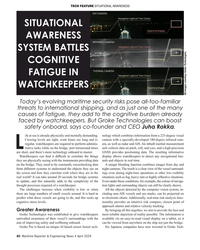 )
April 2024 - Maritime Reporter and Engineering News page: 40
)
April 2024 - Maritime Reporter and Engineering News page: 40TECH FEATURE SITUATIONAL AWARENESS SITUATIONAL AWARENESS SYSTEM BATTLES COGNITIVE FATIGUE IN WATCHKEEPERS All images courtesy Groke Technologies Today’s evolving maritime security risks pose all-too-familiar threats to international shipping, and as just one of the many causes of fatigue, they add
-
 )
April 2024 - Maritime Reporter and Engineering News page: 39
)
April 2024 - Maritime Reporter and Engineering News page: 39Tech Files Latest Products, Systems and Ship Designs “Wall Climbing Robot” Danish Pilot calls gets ClassNK Nod LEGO Model "A tribute build to a work life at sea" Image courtesy MOL, Sumitomo Heavy Industries lassNK granted its Innovation Endorse- Image courtesy Espen Andersen/DanPilot ment for
-
 )
April 2024 - Maritime Reporter and Engineering News page: 38
)
April 2024 - Maritime Reporter and Engineering News page: 38Tech Files Latest Products, Systems and Ship Designs Zero-Emission Mooring Service of a Tanker Consulmar achieved a milestone by executing what it calls ing boat Castalia, which operates on full electric propulsion. the world's ? rst zero-emissions mooring service for a tanker. Equipped with two 150 kW
-
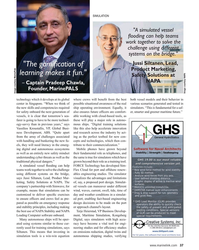 )
April 2024 - Maritime Reporter and Engineering News page: 37
)
April 2024 - Maritime Reporter and Engineering News page: 37SIMULATION "A simulated vessel ? ooding can help teams work together to solve the challenge using different systems on the bridge." – Jussi Siltanen, Lead, "The gami? cation of Product Marketing, learning makes it fun." Safety Solutions at NAPA – Captain Pradeep Chawla, Founder, MarinePALS Image
-
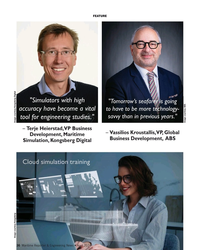 )
April 2024 - Maritime Reporter and Engineering News page: 36
)
April 2024 - Maritime Reporter and Engineering News page: 36FEATURE "Simulators with high "Tomorrow’s seafarer is going accuracy have become a vital to have to be more technology- savvy than in previous years." tool for engineering studies." Image courtesy ABS – Terje Heierstad, VP Business – Vassilios Kroustallis, VP, Global Development, Maritime Business
-
 )
April 2024 - Maritime Reporter and Engineering News page: 35
)
April 2024 - Maritime Reporter and Engineering News page: 35, oil spill detection and recovery simulations and all-en- fun, he says. compassing safety and crisis management drills. There are practical bene? ts. Virtual reality headsets with the The ABS Global LNG Academy in Qatar features Meta- right training package can instruct seafarers how to use spe- SHIPs
-
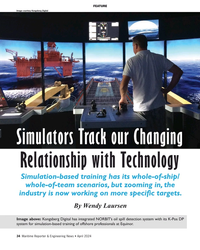 )
April 2024 - Maritime Reporter and Engineering News page: 34
)
April 2024 - Maritime Reporter and Engineering News page: 34FEATURE Image courtesy Kongsberg Digital Simulators Track our Changing Relationship with Technology Simulation-based training has its whole-of-ship/ whole-of-team scenarios, but zooming in, the industry is now working on more speci? c targets. By Wendy Laursen Image above: Kongsberg Digital has integrated
-
 )
April 2024 - Maritime Reporter and Engineering News page: 32
)
April 2024 - Maritime Reporter and Engineering News page: 32FEATURE A closeup of a blade installation process taken via drone. A blade handling system is apparent (in yellow). Images courtesy of Mammoet requirement for the development of these cranes, particularly ling area. This would result in a major time and fuel saving. in ? oating offshore wind,” says
-
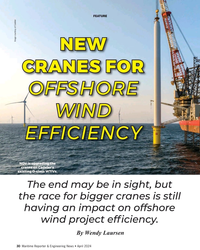 )
April 2024 - Maritime Reporter and Engineering News page: 30
)
April 2024 - Maritime Reporter and Engineering News page: 30FEATURE Image courtesy of Cadeler NEW CRANES FOR OFFSHORE WIND EFFICIENCY NOV is upgrading the cranes on Cadeler’s existing O-class WTIVs. The end may be in sight, but the race for bigger cranes is still having an impact on offshore wind project ef? ciency. By Wendy Laursen 30 Maritime Reporter
-
 )
April 2024 - Maritime Reporter and Engineering News page: 28
)
April 2024 - Maritime Reporter and Engineering News page: 28FEATURE INTERVIEW track missiles and warheads for the Mis- sile Defense Agency, and it travels with its support ship, the MV Hercules. For our Service Support ships, we have the two hospital ships, USNS Mer- cy and Comfort; two rescue and salvage ships; two submarine tenders; and the Sixth Fleet ?
-
 )
April 2024 - Maritime Reporter and Engineering News page: 27
)
April 2024 - Maritime Reporter and Engineering News page: 27RADM PHILIP SOBECK, MILITARY SEALIFT COMMAND With COVID, we had to make some hard choices for our Do your CIVMARs have upward mobility? mariners because we couldn’t rotate. Many of our mariners The Navy has Sailors who become “Mustangs,” and work found other employment, and were able to use their skills
-
 )
April 2024 - Maritime Reporter and Engineering News page: 26
)
April 2024 - Maritime Reporter and Engineering News page: 26FEATURE INTERVIEW “Over the next decade, 12 new classes of ships will come online and MSC will see up to 20 new ships deliver to the ? eet in the next ? ve years. This includes new oilers, towing, salvage and rescue tugs, and expeditionary fast transports and emergency medical ships. A large
-
 )
April 2024 - Maritime Reporter and Engineering News page: 25
)
April 2024 - Maritime Reporter and Engineering News page: 25RADM PHILIP SOBECK, MILITARY SEALIFT COMMAND Photo by Brian Suriani USN Military Sealift Command From a global supply chain perspective, What makes MSC so vital to the we’ve learned a lot about dealing with Navy’s ? eet and our military disruptions. COVID delivered a big forces around the world? wake-up
-
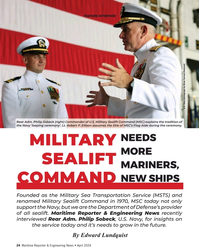 )
April 2024 - Maritime Reporter and Engineering News page: 24
)
April 2024 - Maritime Reporter and Engineering News page: 24FEATURE INTERVIEW U.S. Navy photograph by Brian Suriani/Released Rear Adm. Philip Sobeck (right) Commander of U.S. Military Sealift Command (MSC) explains the tradition of the Navy ‘looping ceremony’. Lt. Robert P. Ellison assumes the title of MSC’s Flag Aide during the ceremony. NEEDS MILITARY MORE
-
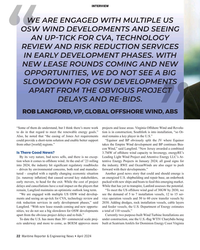 )
April 2024 - Maritime Reporter and Engineering News page: 22
)
April 2024 - Maritime Reporter and Engineering News page: 22INTERVIEW WE ARE ENGAGED WITH MULTIPLE US OSW WIND DEVELOPMENTS AND SEEING AN UP-TICK FOR CVA, TECHNOLOGY REVIEW AND RISK REDUCTION SERVICES IN EARLY DEVELOPMENT PHASES. WITH NEW LEASE ROUNDS COMING AND NEW OPPORTUNITIES, WE DO NOT SEE A BIG SLOWDOWN FOR OSW DEVELOPMENTS APART FROM THE OBVIOUS
